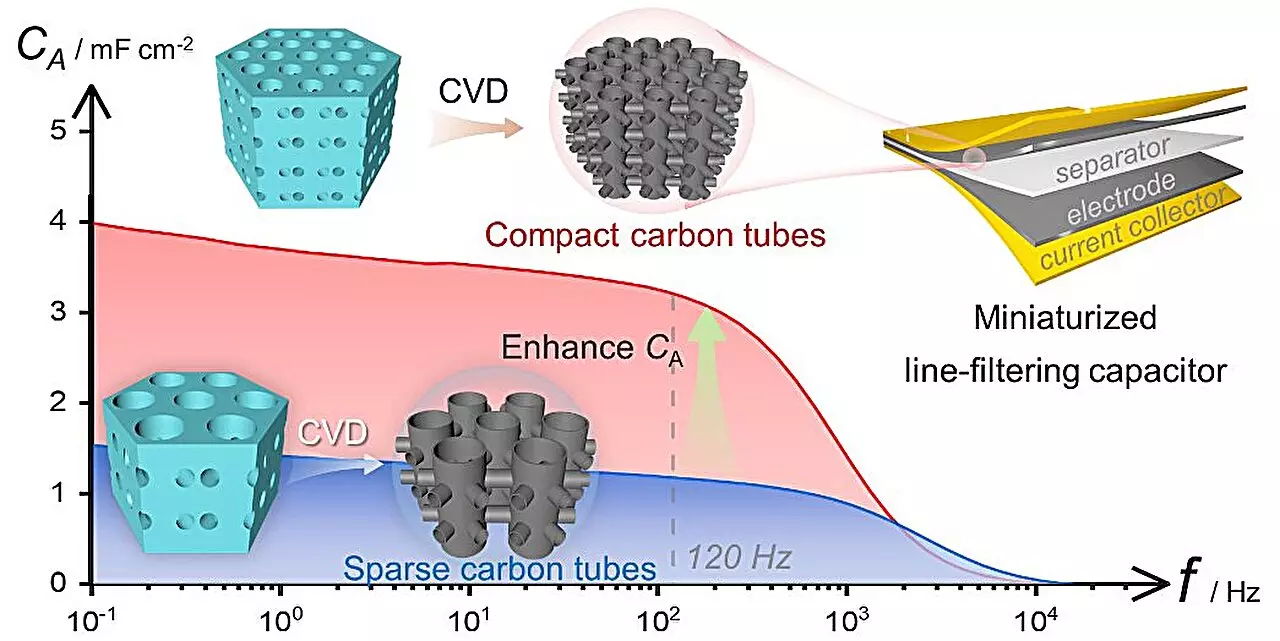In a recent study published in Nano-Micro Letters, a research team led by Prof. Meng Guowen and Prof. Han Fangming from the Hefei Institutes of Physical Science of the Chinese Academy of Sciences, along with Prof. Wei Bingqing from the University of Delaware and Prof. Li Xiaoyan from Tsinghua University, introduced a groundbreaking approach to constructing high-density three-dimensional carbon tube nanoarray electrodes for line-filtering capacitors. The development showcases significant potential for enhancing the performance of miniaturized filter devices.
Filter capacitors play a crucial role in converting fluctuating voltage signals into steady direct current. While Aluminum electrolytic capacitors (AECs) are commonly used, they are large in size and have limited capacitance, posing challenges in shrinking modern electronic devices. On the other hand, electric double-layer capacitors (EDLCs) offer higher energy density, making them a promising alternative for smaller filter capacitor applications. However, traditional carbon-based EDLCs face limitations due to slow ion transport, hindering their ability to achieve both high energy density and quick frequency response required for line-filtering applications.
The research team implemented a systematic study aimed at manipulating the pore structure of three-dimensional interconnected porous anodized aluminum oxide (3D-AAO) templates. By tuning the vertical pore diameter of 3D-AAO from 70 to 250 nm and adjusting the inter-pore spacing from 100 to 450 nm, they successfully fabricated 3D compactly arranged carbon tube (3D-CACT) nanoarray electrodes using chemical vapor deposition. The specific surface area tests revealed that optimizing the pore diameter and inter-spacing significantly increased the electrode’s surface area, enhancing its performance.
The resulting 3D-CACT electrode-based device demonstrated exceptional frequency response performance, characterized by a phase angle of -80.2° at 120 Hz, an ultra-low equivalent series resistance of less than 0.07 Ω cm2, and a rapid resistance-capacitance time constant of 0.25 ms. Notably, the specific areal capacitance at 120 Hz reached 3.23 mF cm-2, surpassing commercial AECs and previously reported line-filtering EDLCs. This underscores the 3D-CACT nanoarray’s ability to facilitate efficient ion transport and provide abundant charge adsorption sites, enhancing overall performance.
Researchers successfully demonstrated the scalability of their approach by connecting multiple sets of identical 3D-CACT-based EDLCs in series, extending the capacitors’ operating voltage while maintaining rapid frequency response and low loss characteristics. By utilizing series-connected devices as filters, they effectively converted various alternating current inputs into smooth direct current signals, showcasing performance comparable to commercial AECs. The high-density 3D-CACT nanoarray electrodes offer promising solutions for high-performance filter capacitors, advancing miniaturized power systems and electronics.
The development of high-density three-dimensional carbon tube nanoarray electrodes represents a significant advancement in the field of line-filtering capacitors. By leveraging innovative technologies and precise manipulation of pore structures, the research team has paved the way for enhanced performance, scalability, and practical applications in miniaturized power systems and electronics. The potential of 3D-CACT nanoarrays to revolutionize filter capacitor design and functionality is a promising step towards improving efficiency and reliability in electronic devices.


Leave a Reply